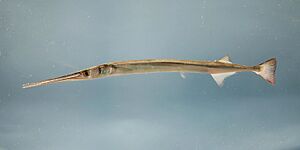Strongylura marina facts for kids
The Atlantic needlefish (Strongylura marina) is a long, thin fish often found in calm waters like marinas. It has a very long jaw and body, which helps it stand out from other fish that hunt. These fish live in the ocean from Maine all the way down to Brazil. They can even swim into fresh water for a short time!
Quick facts for kids Strongylura marina |
|
|---|---|
 |
|
| Conservation status | |
| Scientific classification | |
| Synonyms | |
|
Contents
Where Atlantic Needlefish Live
Atlantic needlefish, also known as Strongylura marina, live along the western Atlantic coast. You can find them from Maine down to southern Brazil. This includes places like the Gulf of Mexico and the Caribbean Sea.
These fish don't just stay in the ocean. They can also be found in different estuaries, which are areas where fresh river water mixes with salty ocean water. They can even swim far up into rivers where the water is completely fresh! For example, they live in the shallow waters of the Chesapeake Bay.
In Texas, Atlantic needlefish are found in many river systems. They have also been introduced to parts of the Tennessee River in Alabama and Tennessee.
What Atlantic Needlefish Eat
When Atlantic needlefish are young, their diet is mostly small sea creatures. About 70% of what they eat is shrimp, mysids (which are like tiny shrimp), and amphipods (small crustaceans). The other 30% of their diet is made up of other small fish.
As they grow into adults, Atlantic needlefish become full-time fish eaters. This means they only eat other fish.
Who Eats Atlantic Needlefish?
Larger fish that also eat other fish are the main predators of the Atlantic needlefish. For example, the Atlantic tarpon is a big fish that hunts them.
Less common predators include the common bottlenose dolphin and young lemon sharks. Since Atlantic needlefish often swim right at the surface of the water, some birds also hunt them.
Atlantic needlefish compete for food with other fish that are about the same size and also eat fish, like bonefish.
These fish can live in a wide range of saltiness levels in the water. Even though they prefer salty water, they can easily adapt to fresh water and often swim into rivers.
Life Cycle and Reproduction
Atlantic needlefish usually lay their eggs in late spring and during the summer. In Texas, females have been found with eggs ready to be laid as early as February.
The eggs of the Atlantic needlefish are special because they have many long, thin threads. These threads help the eggs stick to floating plants or other things underwater.
Atlantic needlefish become old enough to reproduce when they are two years old. They lay their eggs in shallow areas near the coast where there are lots of underwater plants. In the Gulf of Mexico, their eggs often attach to sargassum seaweed. These underwater plants are very important for the fish to breed and find shelter.
Conservation Status
The Atlantic needlefish is not currently considered an endangered species. It's not a very important fish for commercial fishing, but people do catch them sometimes. They are also caught by accident when fishermen are trying to catch other fish.
Sport fishermen sometimes catch Atlantic needlefish with a fishing rod or a net. They then use these fish as bait to catch bigger fish.


